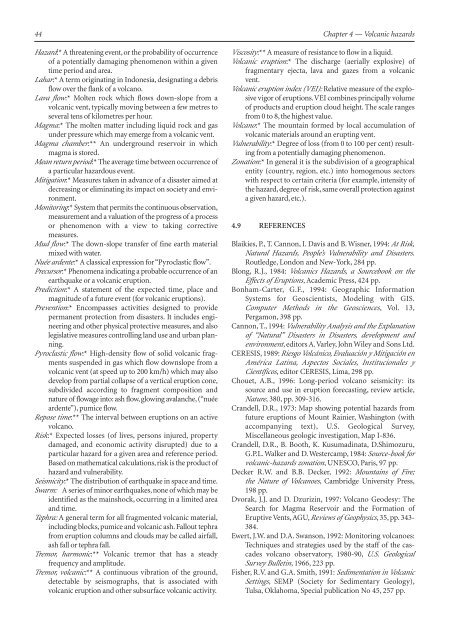Comprehensive Risk Assessment for Natural Hazards - Planat
Comprehensive Risk Assessment for Natural Hazards - Planat
Comprehensive Risk Assessment for Natural Hazards - Planat
You also want an ePaper? Increase the reach of your titles
YUMPU automatically turns print PDFs into web optimized ePapers that Google loves.
44<br />
Hazard:* A threatening event, or the probability of occurrence<br />
of a potentially damaging phenomenon within a given<br />
time period and area.<br />
Lahar:* A term originating in Indonesia, designating a debris<br />
flow over the flank of a volcano.<br />
Lava flow:* Molten rock which flows down-slope from a<br />
volcanic vent, typically moving between a few metres to<br />
several tens of kilometres per hour.<br />
Magma:* The molten matter including liquid rock and gas<br />
under pressure which may emerge from a volcanic vent.<br />
Magma chamber:** An underground reservoir in which<br />
magma is stored.<br />
Mean return period:* The average time between occurrence of<br />
a particular hazardous event.<br />
Mitigation:* Measures taken in advance of a disaster aimed at<br />
decreasing or eliminating its impact on society and environment.<br />
Monitoring:* System that permits the continuous observation,<br />
measurement and a valuation of the progress of a process<br />
or phenomenon with a view to taking corrective<br />
measures.<br />
Mud flow:* The down-slope transfer of fine earth material<br />
mixed with water.<br />
Nuée ardente:* A classical expression <strong>for</strong> “Pyroclastic flow”.<br />
Precursor:* Phenomena indicating a probable occurrence of an<br />
earthquake or a volcanic eruption.<br />
Prediction:* A statement of the expected time, place and<br />
magnitude of a future event (<strong>for</strong> volcanic eruptions).<br />
Prevention:* Encompasses activities designed to provide<br />
permanent protection from disasters. It includes engineering<br />
and other physical protective measures, and also<br />
legislative measures controlling land use and urban planning.<br />
Pyroclastic flow:* High-density flow of solid volcanic fragments<br />
suspended in gas which flow downslope from a<br />
volcanic vent (at speed up to 200 km/h) which may also<br />
develop from partial collapse of a vertical eruption cone,<br />
subdivided according to fragment composition and<br />
nature of flowage into: ash flow, glowing avalanche, (“nuée<br />
ardente”), pumice flow.<br />
Repose time:** The interval between eruptions on an active<br />
volcano.<br />
<strong>Risk</strong>:* Expected losses (of lives, persons injured, property<br />
damaged, and economic activity disrupted) due to a<br />
particular hazard <strong>for</strong> a given area and reference period.<br />
Based on mathematical calculations, risk is the product of<br />
hazard and vulnerability.<br />
Seismicity:* The distribution of earthquake in space and time.<br />
Swarm: A series of minor earthquakes, none of which may be<br />
identified as the mainshock, occurring in a limited area<br />
and time.<br />
Tephra: A general term <strong>for</strong> all fragmented volcanic material,<br />
including blocks, pumice and volcanic ash. Fallout tephra<br />
from eruption columns and clouds may be called airfall,<br />
ash fall or tephra fall.<br />
Tremor, harmonic:** Volcanic tremor that has a steady<br />
frequency and amplitude.<br />
Tremor, volcanic:** A continuous vibration of the ground,<br />
detectable by seismographs, that is associated with<br />
volcanic eruption and other subsurface volcanic activity.<br />
Chapter 4 — Volcanic hazards<br />
Viscosity:** A measure of resistance to flow in a liquid.<br />
Volcanic eruption:* The discharge (aerially explosive) of<br />
fragmentary ejecta, lava and gazes from a volcanic<br />
vent.<br />
Volcanic eruption index (VEI): Relative measure of the explosive<br />
vigor of eruptions.VEI combines principally volume<br />
of products and eruption cloud height. The scale ranges<br />
from 0 to 8, the highest value.<br />
Volcano:* The mountain <strong>for</strong>med by local accumulation of<br />
volcanic materials around an erupting vent.<br />
Vulnerability:* Degree of loss (from 0 to 100 per cent) resulting<br />
from a potentially damaging phenomenon.<br />
Zonation:* In general it is the subdivision of a geographical<br />
entity (country, region, etc.) into homogenous sectors<br />
with respect to certain criteria (<strong>for</strong> example, intensity of<br />
the hazard, degree of risk, same overall protection against<br />
a given hazard, etc.).<br />
4.9 REFERENCES<br />
Blaikies,P.,T.Cannon,I.Davis and B.Wisner,1994:At <strong>Risk</strong>,<br />
<strong>Natural</strong> <strong>Hazards</strong>, People’s Vulnerability and Disasters.<br />
Routledge, London and New-York, 284 pp.<br />
Blong, R.J., 1984: Volcanics <strong>Hazards</strong>, a Sourcebook on the<br />
Effects of Eruptions, Academic Press, 424 pp.<br />
Bonham-Carter, G.F., 1994: Geographic In<strong>for</strong>mation<br />
Systems <strong>for</strong> Geoscientists, Modeling with GIS.<br />
Computer Methods in the Geosciences, Vol. 13,<br />
Pergamon, 398 pp.<br />
Cannon, T., 1994: Vulnerability Analysis and the Explanation<br />
of “<strong>Natural</strong>” Disasters in Disasters, development and<br />
environment, editors A.Varley, John Wiley and Sons Ltd.<br />
CERESIS, 1989: Riesgo Volcánico, Evaluación y Mitigación en<br />
América Latina, Aspectos Sociales, Institucionales y<br />
Científicos, editor CERESIS, Lima, 298 pp.<br />
Chouet, A.B., 1996: Long-period volcano seismicity: its<br />
source and use in eruption <strong>for</strong>ecasting, review article,<br />
Nature, 380, pp. 309-316.<br />
Crandell, D.R., 1973: Map showing potential hazards from<br />
future eruptions of Mount Rainier, Washington (with<br />
accompanying text), U.S. Geological Survey,<br />
Miscellaneous geologic investigation, Map I-836.<br />
Crandell, D.R., B. Booth, K. Kusumadinata, D.Shimozuru,<br />
G.P.L. Walker and D. Westercamp, 1984: Source-book <strong>for</strong><br />
volcanic-hazards zonation, UNESCO, Paris, 97 pp.<br />
Decker R.W. and B.B. Decker, 1992: Mountains of Fire;<br />
the Nature of Volcanoes, Cambridge University Press,<br />
198 pp.<br />
Dvorak, J.J. and D. Dzurizin, 1997: Volcano Geodesy: The<br />
Search <strong>for</strong> Magma Reservoir and the Formation of<br />
Eruptive Vents,AGU, Reviews of Geophysics, 35, pp. 343-<br />
384.<br />
Ewert, J.W. and D.A. Swanson, 1992: Monitoring volcanoes:<br />
Techniques and strategies used by the staff of the cascades<br />
volcano observatory, 1980-90, U.S. Geological<br />
Survey Bulletin, 1966, 223 pp.<br />
Fisher, R.V. and G.A. Smith, 1991: Sedimentation in Volcanic<br />
Settings, SEMP (Society <strong>for</strong> Sedimentary Geology),<br />
Tulsa, Oklahoma, Special publication No 45, 257 pp.

















